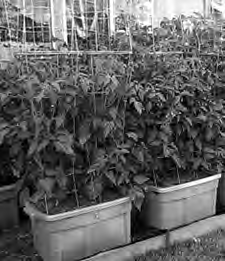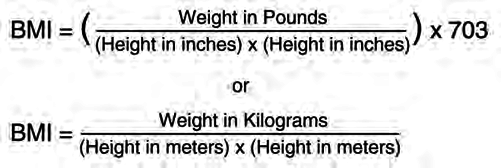100 Perks of Having Cancer: Plus 100 Health Tips for Surviving It (82 page)
Read 100 Perks of Having Cancer: Plus 100 Health Tips for Surviving It Online
Authors: Florence Strang
Tags: #Health; Fitness & Dieting, #Diseases & Physical Ailments, #Internal Medicine, #Oncology, #Cancer, #Medicine & Health Sciences, #Clinical, #Medical Books, #Alternative Medicine, #Medicine

the planting medium. You don’t need any
dirt as you plant directly into the straw.
The bale has to be “conditioned” first
by either watering for three weeks (the
organic way) or by pouring fertilizer on
the bale (the fast way). The straw starts
to break down to form compost, thereby
enriching the plants as they grow. You
can use the bale for two years, and then it
This is what an ideal straw bale garden
becomes compost for other areas of your
looks like.
garden. This site—www.strawbalegardens
.com—ex plains it all step by step.
This technique works well in very
limited spaces and you can place the bale
on a lawn or on concrete and still get
great results. I heard of this idea from my
husband’s coworker, and I knew I wanted
to try it when I saw the big delicious
homegrown tomatoes he produced from
just one tomato plant!
Container Gardening
Another convenient way to grow your
veggies is in containers. You can recycle
old wood into garden boxes (but make
sure the wood has NOT been chemically
This is what MY straw bale garden looks like.
treated!), or reuse pots, buckets, or other
If I cared about neatness more, this would be
containers. Make sure the containers
nice and square, but it serves the purpose
have plenty of drainage holes, as root sys-
and is giving me the most delicious tomatoes
tems need air as well as water. Fill with a
I ever grew!


Perk #81: A Good Reason to Spend More Time in My Garden
345
lightweight potting mix (garden soil is usually too heavy), add in lots of
compost, set in your seeds or young plants, and keep them well watered.
It’s so nice to need no tilling and grow no weeds! Con-
tainers do tend to dry out quickly, however, so be sure to
keep them well watered. Here is a great site to get you
started: http://ohioline.osu.edu/hyg-fact/1000/1647.html.
If you feel particularly ambitious, you can build an
EarthTainer from simple plastic storage totes. These ingen-
ious portable gardens contain a simple watering mecha-
nism that allows the plant root system to draw water from
the bottom of the container supplied though a watering
tube from the top. Watering through the tube not only
brings the water directly to the root system, but it saves
water as nothing is wasted. Visit http://earthtainer.tomatofest.com for instruc-
tions and more information.
Community Gardens
If you want the feel of being a real farmer, but just don’t have the space,
then sign up for a plot or allotment at a community garden. A community
garden consists of any group of people that use a common
shared gardening area to grow their plants. Usually the land
With just a little effort,
is provided by the city and there is a small fee involved, but
and almost no dirt,
much of the work of preparing the soil has already been
you can grow healthy
done for you. Despite their names, they don’t really have
food right at home!
to be “communal,” where everyone shares the work and the
harvest, but some are. Gardeners can have their own indi-
vidual plot within the community garden and, if they choose, can also join
with others to grow some crops communally. Contact your local munici-
pality to get started.
Take it from a city girl who, at one time, couldn’t grow her own hair:
there’s nothing like the satisfaction of eating fresh, homegrown, pesticide-
free veggies!


Perk #82
Cancer Helped Me
to Grow as a Psychologist
I
n my practice as a psychologist, I use a form of counseling known as
cognitive-behavioral therapy (CBT). CBT was popularized in the 1980s by
Dr. David Burns, bestselling author of
Feeling Good—The New Mood Therapy
and
The Feeling Good Handbook
. The basic premise behind CBT is that your
thoughts are directly responsible for how you feel. Therefore, you can
improve your moods by choosing more positive thoughts. While the situa-
tion itself does not change (the divorce, the illness, the bankruptcy), by
changing how you
think
about it, you can change how you
feel
about it. It
is all about attitude.
Nineteenth-century philosopher and psychologist William James wrote,
“The greatest discovery of my generation is that a human being can alter
his life by altering his attitudes of mind.” This is a philosophy that I strive
to live my life by. I believe that my quality of life is not so much determined
by the events of my life, but rather by the attitude that I bring to it and,
more specifically, the thoughts I choose to think about it.
I made it my mission in life to always seek out the positive and try to
find the silver lining behind every cloud. At times this was difficult, especially
with broken relationships and my son Ben’s diagnosis of autism, but no mat-
ter what the challenge, I strived to stay positive. Then came the ultimate test:
I was diagnosed with cancer. Sure, I could talk the talk about the benefits
of a positive attitude, but could I walk the walk when I most needed to do
so? Would I be able to use the power of my thoughts to feel good through
my cancer journey? I believe this book demonstrates that I passed the test!
Attitude is a choice. I did not have a choice in getting cancer, but I did
have a choice in how I was going to face it. Choosing to face cancer with
a survivor’s attitude not only made the experience more bearable, but it
also reinforced my belief in cognitive-behavioral therapy and helped me
to be a better counselor.
I 346 J

Perk #82: Cancer Helped Me to Grow as a Psychologist
347
Getting cancer is not a choice,
but the attitude you bring to it is a choice.
HEALTH TIP #82
Choosing the Diet That’s Right for You
A
nyway you slice it,
diet
is a four-letter word. It evokes feelings of sac-
rifice and pain. Diets can also come with personal agendas that are
defended from attack with sharp knives and forks. Discussing one’s diet can
become as personal and heated a subject as “boxers or briefs.”
My question is: In order to eat healthy, do you have to limit yourself to
one type of “diet”? My answer is: Would you limit yourself to just one pair
of shoes? Absurd.
Understand first, that you don’t just eat food; you have a relationship
with food. Eating is not just satisfying your hunger, it is pleasuring your
senses of smell, feel, taste, and sight. So when your task is “eat healthier,”
you have to fulfill and satisfy all these senses, not just replace new foods for
old. This can be tricky. That fast-food burger that you associate with immense
“pleasure” is going to be hard to replace. Hard . . . but not impossible.
A lot has been learned over the years about how food can be used to
prevent and treat illnesses. We know that there is immense power that lies
in the food choices you make every day. Foods can have beneficial or detri-
mental effects at your very basic cellular level, but it seems that food, when
eaten whole, as close to its original form (for example, an apple vs. apple
sauce), has the most healing power. It was noted that those who ate more
foods high in beta-carotene (vitamin A) for example had a lower incidence
of lung cancer. So it might make sense that, if high doses of vitamin A were
given to subjects, they would have an even lower incidence of lung cancer
than those that ate high vitamin A–foods. To researchers’ surprise, the lung
cancer rates were actually higher in the vitamin A–supplement group than
in the vitamin A–food group, suggesting that the magic lies in the whole,

